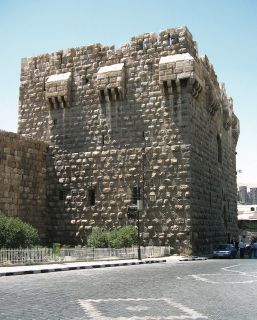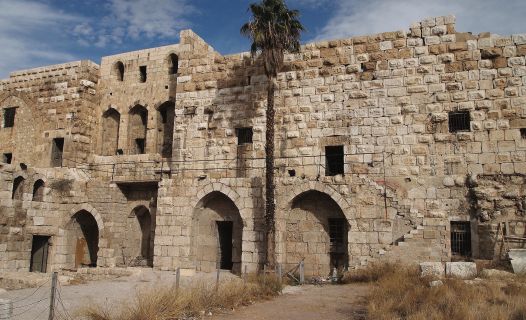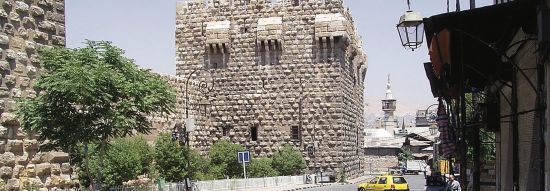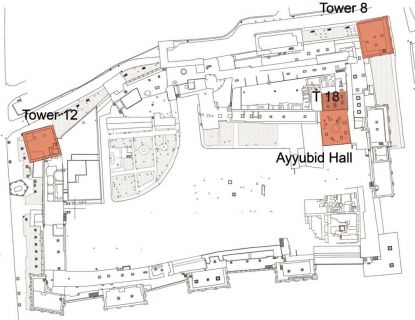Citadel of Damascus
Syria Damascus 11th Century
Castle of DamascusOlarak da bilinir.
Seljuk
The Citadel of Damascus was continuously developed and underwent many alterations after its first construction. The walls surrounding the city, date ta a much earlier period. Damascus, which has always been the capital of Syria, was also one of the most important cities during the Seljuk period. Founded on the foothills of Mount Kassioun, Damascus straddles both banks of the Barada River, which runs through the middle of the city. While the great majority of medieval castles were built on high cliffs, the Citadel of Damascus was built on the plain. Probably the major reason far building the Citadel here was ta control the water carried by the Barada River. Water supply was the most crucial need of this city, located at the edge of the desert and on the westbound caravan route along the river.
There was also a connection, via a canal, between the Barada River and the ditches around the castle. This canal was used when the city was under siege. These ditches are completely filled in today, and some of the city walls around them were destroyed.
It is thought that the massive construction of the walls was indestructible during the Seljuk
period. The last stop for caravans before reaching the Mediterranean Sea, Damascus became a prosperous commercial city. It had grown in significance from ancient times onward and continued its prominent status in the Islamic period. When the Muslims conquered Damascus, they constructed many buildings in the city, of which the monumental Damascus Umayyad Mosque is the most outstanding of all.
Although additions were made to this building during the Seljuk period, the Citadel was unquestionably the most important construction effort of the Seljuks. After Damascus was conquered by the Muslims in 635, the city became the administrative capital of the Omeyyads. However, it was not as developed as the other Islamic cities of the era, such as Cairo, Merv or Baghdad. The most noteworthy monument of the Omayyad Period is, without a doubt, the Damascus Umayyad Mosque. The city was designed in the Roman Period in a grid {Hippodamos) urban plan. This plan continued to exist in the core of the city for a certain period. Researchers suggest that the "Souqs" in the city center derive from this grid plan. When the Caliphate passed to the Abbasids in 750, the capital moved to Baghdad. The development of Damascus slowed down after this date. The classic grid plan altered significantly, and the city began to develop with a more spontaneous plan responding to the imperatives of the inhabitants. Different religious groups began to live in their own neighbourhoods, surrounded by the city walls, at the beginning of the 10th century.
Damascus and its surroundings came under the control of the Fatimids and the Ikhshidids before it was conquered by the Seljuks. The Seljuks appeared in the region in 1076, after which the city came under their rule. The Seljuks began extensive construction activity in the city. Although citadel architecture was known in the Middle East before the Seljuks, the Seljuks emphasised the construction of citadels, due ta the need far defense in a period in which cities constantly changed hands. The Seljuks surrounded a section of the outer city walls of Damascus from the inside and transformed it into a castle. This had become necessary because the city walls had become too decrepit ta ensure a reliable defense. The Citadel was first built during the reign of the Turkmen Beg Atsiz lbn Uvak, and completed during the reign of Malik Shah’s brother Tutush. Although the Citadel preserved its basic architecture and plan after having undergone various additions and repairs, some elements were changed. The building served as a military base far the Crusaders, who came ta the region after the Seljuk period.
Most of the Citadel was destroyed by the Ayyubid administrator, Al-Adil, in 1202. it was reconstructed by using hard stones, such as basalt. The Citadel was attacked six times when the Mongols were in the region (1226-1312). The Citadel's walls were seriously damaged after the siege of the city by Timur, but were repaired after each battering. Various buildings were erected inside the Citadel which served as a garrison far troops during the Ottoman period.
One of the most glorious examples of the architecture of the Middle Ages, the Citadel had 12 simple towers. The entrance ta the Citadel is through three different gates. Although most of the walls of the Citadel belong ta the Ayyubid period of the 13th century, some of them date ta the Seljuk period. The castle walls are mostly original. Most of the towers have three floors. Some buildings in the Citadel have not survived. There was probably a palace used by Tutush in the Citadel during the Seljuk period. Archaeological excavations began in the Citadel shortly before the current civil war, and important finds, belonging ta the different periods, were found. It is thought that the large building inside the Citadel was used far ceremonies. An inscription, demonstrating that the Citadel was built by Tutush, was found during the archaeological excavations carried out in the Damascus castle in 1987. This inscription is in the Damascus National Museum today. It is an important document, as it demonstrates that the building was constructed during the Seljuk period. Although some parts of the inscription are broken, it still can be deciphered. The inscription reads as follows:
"in the name of Compassionate and Merciful God, Construction of this Caliph of the Abbasid Empire, Our master imam imam El Muktedi bi-emrillah amir of believers and Sultan Shehinshah during the reign of the arm of the amir of the believers, head of emperors, master of the Arabs and the Iranians, father of conquest, son of Muhammad, son of Daoud Malik Shah and his brother esteemed Malik, supported, who won victories, crown of the state, Light of the Nation, Son of the honor of believers, Islam emperor Abu Said Tutush, assistant of the amir of the believers ordered. in the reign of the city year 1085."
It is believed that if more archaeological excavations are conducted in the Citadel it will be possible ta uncover additional finds dating from the Seljuk period.
Berthier S., La cittadelle de Damas: les apports d'un etude archeologique. H. Kennedy (Ed.),Musfim Miitary ArcMecture in Greater Syria, Leiden, 2006, 151-164.
Berthier, S., Affili E.,Cittadelle de Damas. Supplement of the Bulletn d'Etudes Orientales, LII LIV, 2002.
Cathcart Kiıg, D.J. (1951). The Defences of the Citadel of Damascus; a Great
Mohammedan Fortress of the Time of the Crusades. Antiquity, xcrv, 57-96.
Cheveddeıı, P. E., (1986). The Citadel of Damascus, [Doctorate Thesis). Los Angeles: University of Calfomia.
Hanish, H. (1993). Der Nordostabschnitt der Zitadelle von Damaskus. Damaszeııer Mitteilungen, 7, 233-296.
Hanspeter Hanisch 1992 ''Die seldschukischeıı Anlagen der Zitadelle von Damaskus", Damaszener Mitteilurıgen Band 6, s. 479499, laf 7S82 Deutsches Archaologisches lnstitııt Station Damaskus. Mainz, 1992.
Henry Cassels Kay, "A Seljukite lnscription at damascus" Joumal of Royal Asiatic Socıety of Great Brittain aııd lreland, Apr. 1897 ss.335-345
Heyman, J., The stone skeleton, lnternational Journal of Solids and Structures, Vol.2, 1966, 249- 279.
Heyman, J., Structural analysis: A historical approach. Cambridge, Cambridge University Press, 1988.
Sauvaget J., La citadelle de Damas, Syria, il, 59- 90 and 1930, 216-241.
Ottani, F., Coisson, E., Affili, E., 'Ancient Citad of Damascus, SYria: analysis, diagnosis and monitoring far conservation and structural consolidation"
Weber, Stefan. Damascus Ottoman Modemity and Urban Transformation 1808-1918. Aarhus, Denmark: Aarhus Universitetsforlag, 2009.
Wulzinger, K., Watzinger, C., Damaskus, Die lslamische Stadt, Berlin- Leipzig, 1924, s.166- 187.






